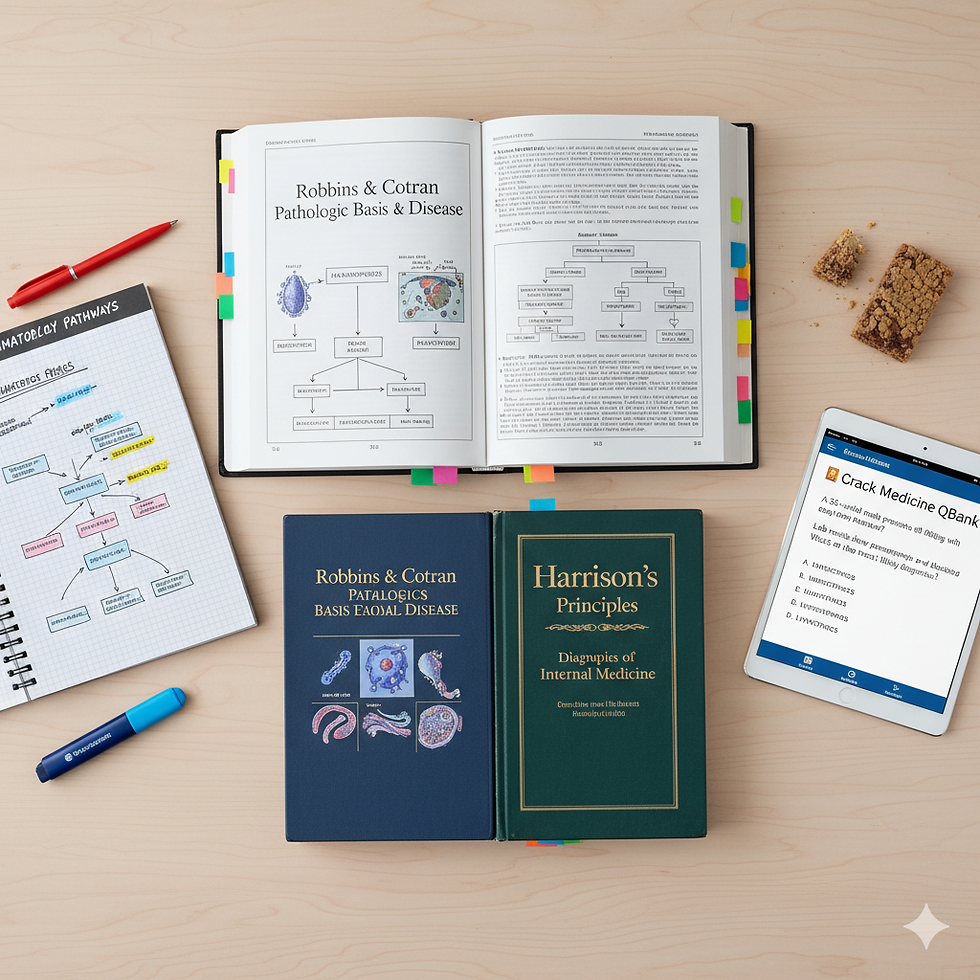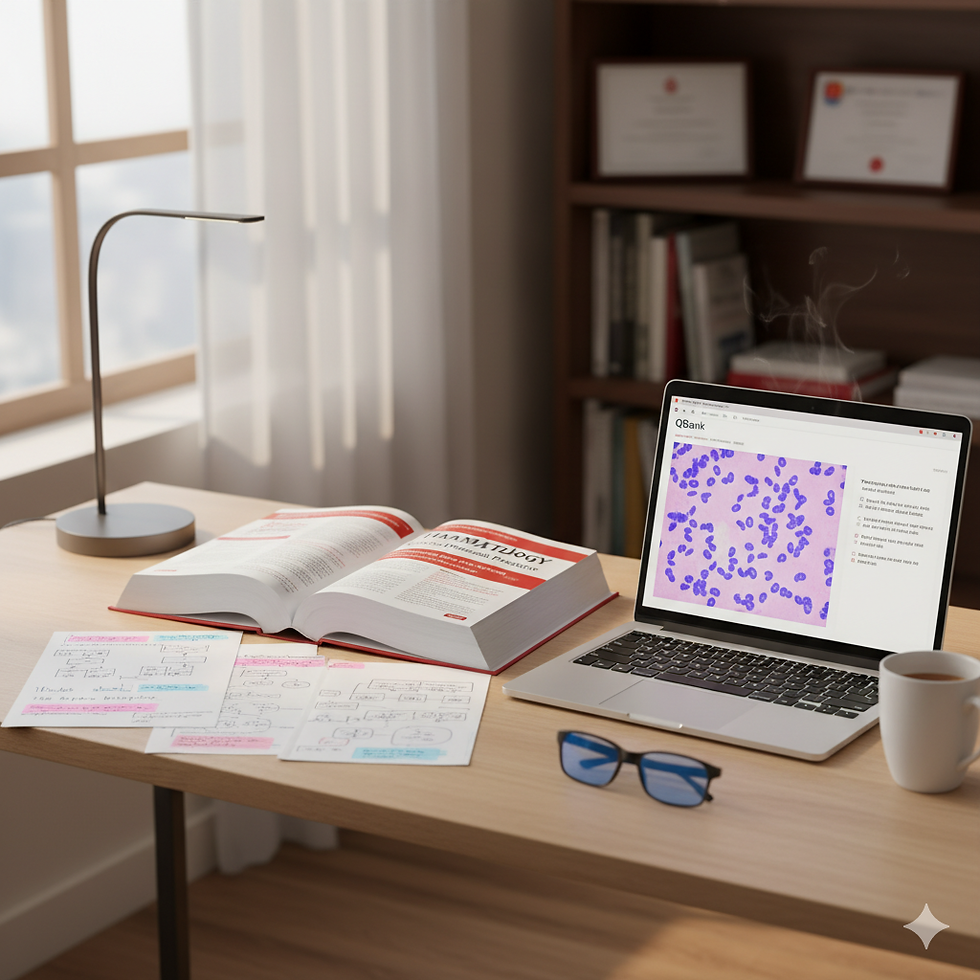Hematology Physiology & Pathophysiology for MRCP Part 1
- Crack Medicine

- 3 days ago
- 4 min read
TL;DR
Understanding hematology physiology & pathophysiology: what MRCP Part 1 expects is vital, because the exam tests mechanistic reasoning of blood-cell production, coagulation and immune cell dynamics rather than simple recall. This article outlines the scope, highlights the most tested sub-topics and revision traps, includes a mini-case and gives you a practical checklist to fix your preparation.
Why this matters
In MRCP Part 1 you won’t just be asked “what is the normal haemoglobin?”, but you’ll be challenged to interpret the how and why of blood-dysfunction: how erythropoiesis adapts to hypoxia, how iron homeostasis fails in chronic disease, how coagulation cascades go awry. The haemato-physiology to pathophysiology transition is a frequent exam theme, and candidates who master this reasoning fare better. Reference sources such as Teach Me Physiology – Haematology highlight that key physiology underpins interpretation of disorders. TeachMePhysiology+2WisTech Open+2Your revision across platforms such as Free MRCP MCQs and Start a mock test will be far more efficient when you slot hematology into a physiology-pathophysiology framework.
Scope: what the exam expects
According to the official blueprint for the exam, about 10 questions are allocated to haematology. thefederation.uk+1 You are expected to cover normal physiology (haematopoiesis, erythrocyte/platelet/white-cell production, iron metabolism, coagulation) and the mechanisms by which these systems fail (e.g., anaemia, thrombosis, haemolysis, bone-marrow failure). The material in the Oxford Academic “Haematology” chapter for MRCP emphasises precisely this: basic science then clinical application. OUP Academic Below we list the five most tested sub-topics, then trap areas to watch.
Five most tested sub-topics
Erythropoiesis & regulation – the role of erythropoietin, kidney hypoxia sensing, stem cell lineage branching.
Tip: draw the lineage tree from HSC → CFU-E → reticulocyte → RBC.
Iron metabolism & anaemia – absorption in duodenum, hepcidin–ferroportin axis, storage (ferritin), transport (transferrin).
Tip: when seeing ferritin low vs high, think iron store vs sequestration.
Coagulation and haemostasis – vascular injury, platelet plug, coagulation cascade (intrinsic/extrinsic), fibrinolysis. NCBI+1
Tip: memorise a simplified cascade and which lab test (PT, aPTT, fibrinogen) corresponds.
Bone-marrow failure / cytopenias – aplastic anaemia, megaloblastic anaemia, myelodysplasia.
Tip: reticulocyte count is a key discriminator.
Haemoglobinopathies & myeloproliferative disorders – e.g., sickle cell mutation, β-thalassaemia, JAK2-positive polycythaemia vera.
Tip: know how genetic mutation leads to abnormal physiology (e.g., HbS polymerisation, increased 2,3-DPG, extramedullary haematopoiesis).
Five common revision traps
Confusing iron‐deficiency anaemia (low ferritin) with anaemia of chronic disease (normal or high ferritin, low transferrin saturation).
Assuming PT and aPTT always rise together – in vitamin K deficiency, PT rises first.
Forgetting the platelet count vs function distinction (e.g., thrombocytopaenia vs Glanzmann’s platelet function defect).
Overlooking that reticulocyte count must be corrected for anaemia severity when interpreting.
Treating haemoglobinopathy genetics as pure “memorise” rather than linking to pathophysiology (for example, how HbS polymerises under hypoxia).
High-yield mechanism summary
Use the table below to refresh and anchor your physiology → pathophysiology links.
# | Mechanism | Key pathophysiological consequence |
1 | ↑ Erythropoietin via renal hypoxia → increased RBC production | Secondary polycythaemia (smoking, renal tumour) |
2 | ↑ Hepcidin (in inflammation) → decreased ferroportin → iron sequestration | Anaemia of chronic disease |
3 | Exposure to tissue-factor (extrinsic) or contact activation (intrinsic) → activation of II, IX, X → fibrin clot | DIC (consumptive coagulopathy) |
4 | Marrow failure (stem-cell injury) → pancytopenia & low reticulocyte count | Aplastic anaemia |
5 | HbS polymerises under hypoxia → rigid erythrocytes | Sickle-cell crises (painful, vaso-occlusive) |

Practical example / mini-case
Case: A 32-year-old male presents with fatigue and pallor. Laboratory results: Hb 88 g/L, MCV 68 fL, ferritin 8 µg/L, transferrin saturation 7 %. Reticulocyte count is low.
Question: What is the most likely mechanism behind his anaemia, and which additional test would you order?
Explanation: The microcytic hypochromic anaemia with very low ferritin and transferrin saturation points to iron‐deficiency anaemia (i.e., depletion of iron stores). The mechanism: inadequate iron → impaired haemoglobin synthesis → reduced RBC production. A low reticulocyte count confirms under-production rather than haemolysis. A useful next test might be colonoscopy (in adult male) or a trial of iron therapy and repeat indices.In contrast, if this were anaemia of chronic disease, ferritin would be normal or high and transferrin saturation low, but iron stores not genuinely depleted.
You can integrate this case practice into your revision using our Free MRCP MCQs or progress to a full timed Start a mock test to simulate the exam condition.
Study-Tip Checklist
Read mechanisms not just facts: ask why a lab result appears, not just what it is.
Use spaced-repetition flashcards for major pathways (iron metabolism, coagulation, erythropoiesis).
Create hand-drawn flowcharts linking physiology → abnormality → clinical presentation → lab result.
Do at least three blocks of 20 timed questions per week focused on haematology via your QBank.
Weekly review: pick one topic from haematology, one from another subject (e.g., endocrinology), and integrate both into a mini-mock.
After each mock, annotate your errors, especially mechanism‐based errors, not just “got it wrong”.
Use the content in our MRCP Part 1 overview post to situate haematology within the wider programme of study and ensure you maintain balance across specialties.
FAQs
Q1: How many questions on haematology physiology & pathophysiology appear in MRCP Part 1?
Typically around 8–12 questions on haematology appear in each sitting, embedded in the ‘clinical sciences’ section, though the exact number varies. thefederation.uk+1
Q2: Should I memorise all coagulation factor numbers and times?
No—instead focus on key patterns (e.g., intrinsic vs extrinsic, PT vs aPTT prolongation) and the physiological reasoning behind abnormal results such as in DIC, liver disease or uremia.
Q3: How should I approach haemoglobinopathy questions?
Focus on the mutation’s effect (e.g., HbS polymerisation) then link to physiology (e.g., sickling, vaso-occlusion) and lab/clinical features (e.g., target cells, vaso-occlusive crises). Pure rote memorisation of names without mechanism is less effective.
Q4: Are bone-marrow histology details required for MRCP Part 1?
Not in depth. You should understand marrow function, reasons for failure (aplastic vs infiltration) and basic trephine vs aspirate differences rather than microscopic morphology.
Q5: What’s the best way to integrate haematology revision with other subjects?
Use the ‘hub-and-spoke’ approach: treat haematology as a spoke linked from the MRCP Part 1 overview hub, and connect its mechanisms to other systems (e.g., renal failure affecting erythropoietin, liver disease affecting coagulation). This ensures contextual integration rather than isolated learning.
Ready to start?
Begin your detailed revision now by visiting our MRCP Part 1 overview to align this haematology topic with your full study plan. Then practise with our Free MRCP MCQs and simulate the pressure via Start a mock test. At Crack Medicine, we help you build understanding, not just memory. Good luck!



Comments